WAR GRAVE
KENNETH WILLIAM MICHIE (grave 28)
SERGEANT
49 SQUADRON
ABOUT MY LIFE
Born: 1916
Died: 7th December 1940
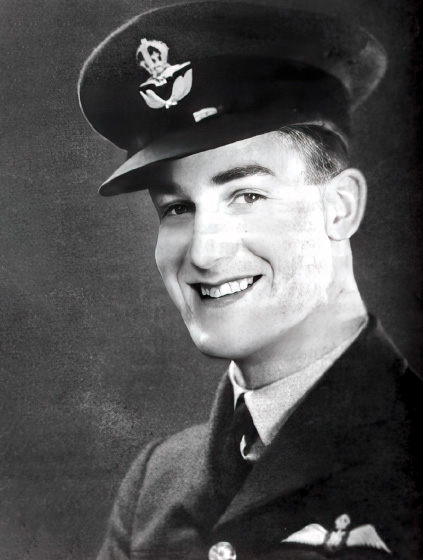
I was from Medicine Hat in Alberta, Canada, the son of Mr and Mrs William Michie. I joined the Royal Air force in December 1938 and was married to Florence May Michie (nee Williams) of Cardiff Wales. I was 24 at the time of my death. In my youth, I had been a Scout with the 2nd Medicine Hat Group, Alberta Troop.
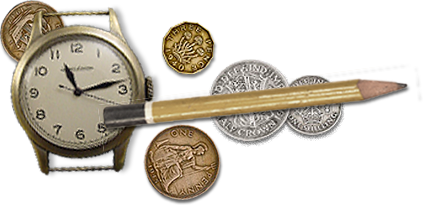
MY AIRCRAFT
The Hampden was a medium bomber with a crew of 4. Pilot, Navigator, Wireless Operator/gunner and a further gunner. Although it was a vast improvement on the biplanes 49 Squadron had been flying just before the war opened, in reality it was already obsolete. Early daylight raids had been a disaster, the bomber was too slow to evade German fighters and its guns were no match for the Germans either. The distinctive fuselage, designed to give the aircraft a sleek, aerodynamic profile, led to the Hampden earning its nickname of “The Flying suitcase”.
Crew: 4
Span: 21.09 m
Length: 16.32 m
Height: 4.37 m
Wing area: 63.90 m²
Empty weight: 5,344 kg
Loaded weight: 8,508 kg
Engine: 2 x Bristol Pegasus XVIII 9-cylinder radial engines
Engine power: 980hp each
Maximum speed: 410 km/h
Rate of climb: 5.00 m/s
Range normal: 1,095 km
4 or 6 x 7.7mm Vickers K machine guns (1 flexible, 1 nose, 1 or 2 dorsal, 1 or 2 ventral)
1,814kg of bombs/mines or 1 x 18in torpedo
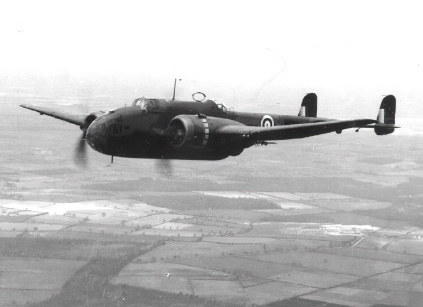
MY ROLE
I was the pilot of this aircraft.
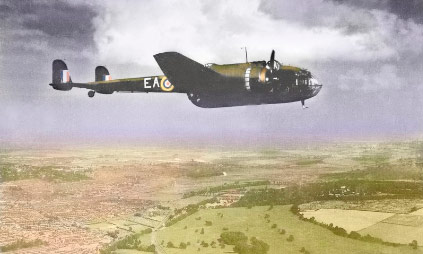
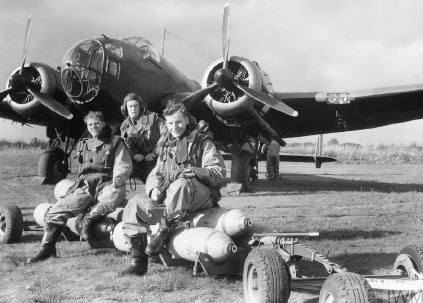
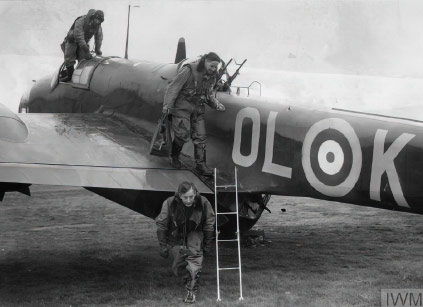
MY SQUADRON
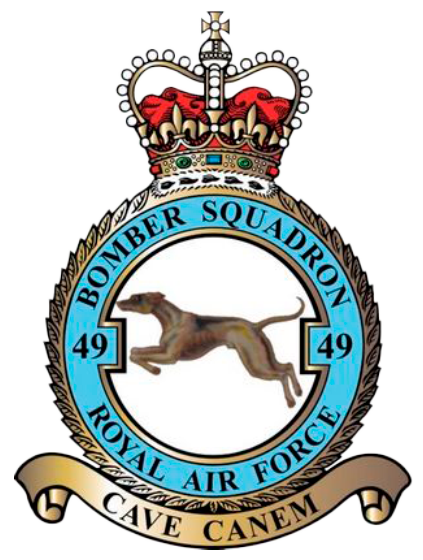
Motto: Cave Canem
Beware of the Dog
49 Squadron was formed at Dover on 15 April 1916 under the command of Major A S Barratt MC and spent its first 18 months as an aircrew training unit equipped with BE2Cs and RE7s. Other documents record that the squadron also trained using Martinsydes. In November 1917 the squadron was re equipped with DH4s and moved to La Bellevue aerodrome in France. Here the squadron was employed in the day bomber role as part of
the 3rd (Army) Wing. Its first raid was made on 26 November 1917. Following the end of hostilities, the squadron was disbanded on 18 July 1919. According to its records 49 Squadron destroyed 56 enemy aircraft drove down another 63 out of control, dropped a total of 120 tons of bombs and operated from 10 airfields in France during the 1914-18 War.
On 10 February 1936, 49 Squadron re-formed at Bircham Newton from a nucleus provided by ‘C’ Flight of No 18 Squadron. It was equipped with Hawker Hind light bombers and initially commanded by Flt Lt J C Cunningham. It moved to Worthy Down in August 1936 where its official badge, depicting a racing greyhound surmounting the motto ‘Cave Canem’ (Beware of the Dog), was presented on 14 June 1937. At first the badge seems inappropriate for a bomber squadron but it is in fact indicative of the performance of the Hawker Hind when compared with its contemporaries. A move to Scampton in March 1938 was followed by conversion to the Handley Page Hampden, the first unit to be equipped with the type.
During the opening months of World War 2 the squadron was employed mainly on reconnaissance, mine laying and leaflet dropping. On 11 May 1940 bombing attacks on Germany began, the oil refineries at Munchen Gladbach being attacked. On 12 August a most successful low level attack on the Dortmund Ems canal was pressed home by Hampdens of 49 Squadron despite fierce opposition. Flt Lt R A B Learoyd received the Victoria Cross for his bravery during the attack, the first awarded in Bomber Command.
The squadron began to re equip with Manchester aircraft in April 1942; however, these aircraft were not in use for long and by July 1942 were replaced by Lancasters which, with their greater range and striking power, extended the scope of the squadron’s operations.
The Squadron stood down from 1-15 January 1943 during which time a move was made to Fiskerton. Operations resumed on 16 January when the squadron attacked Berlin the first of many such visits. For the remainder of the war the squadron continued as a front line bomber squadron and took part in most major operations by Bomber Command including, in August 1943, the vital attack on the rocket research establishment at Peenemunde when the squadron lost four of the twelve Lancasters despatched.
After moving to Fulbeck on 16 October 1944, then Syerston on 22 April 1945, the squadron made its last attack on 25 April when Berchtesgaden was the target. In May the squadron took part in Operation ‘EXODUS’ ferrying ex -prisoners of war back to the UK.
Honours and awards gained by members of 49 Squadron during the Second World War include 1 Victoria Cross, 1 Empire Gallantry Medal (later the George Cross), 7 Distinguished Service Orders, 131 Distinguished Flying Crosses, 2 Conspicuous Gallantry Medals and 105 Distinguished Flying Medals.
Following World War Two, the squadron flew Avro Lincolns and later the Vickers Valliant, the first of the V-bombers. It was in this aircraft that they would take part in the tests of Britain’s first nuclear weapons. From November 1959 the squadron reverted to the normal medium bomber role. It moved to Marham on 26 June 1961. On 5 June 1964 Her Royal Highness Princess Marina, Duchess of Kent, presented 49 Squadron with its standard, which was awarded in April.
49 Squadron was disbanded at RAF Marham on 1 May 1965, when all Valiant aircraft were withdrawn from service.
THE ACCIDENT
On 7th December 1940 my Hampden S for Sugar of 49 Squadron(X3028) was one of a mixed force of forty five Blenheim, Whitley and Hampden aircraft that took-off from various stations to attack airfields in occupied Europe.
Just after midnight, 49 Squadron’s aircraft were returning to Scampton, but S for Sugar came to grief only a couple of miles from home and safety. Whilst in the circuit, our aircraft went out of control and crashed just one mile east of the airfield, near Welton.
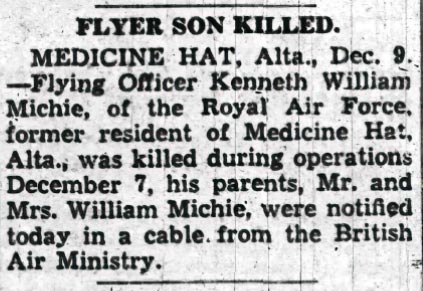
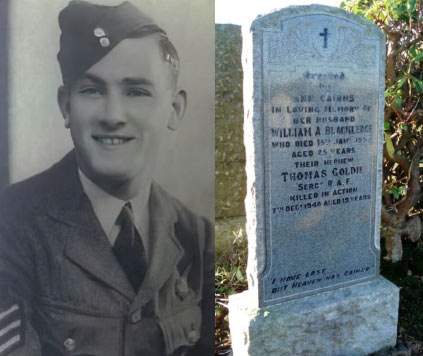
We will never know what happened to cause the pilot to lose control, but fatigue after a stressful mission may well have played a part. Three of the four crew onboard were killed, but miraculously, although very badly injured, Sergeant Barrier, a pilot acting in the capacity of Navigator on the flight survived.
CASUALTIES – 7TH DECEMBER 1940
Flying Officer Kenneth Michie (Pilot) (Buried Scampton)
Sergeant Garton Davenport-Jones (Wop/AG) (Buried Scampton) MORE
Sergeant Thomas Goldie (Air Gunner) (Buried Lesmahagow Cemetery)
Sergeant Barrier (Pilot/Navigator) Survived
Where Next
Visit the grave of Sergeant Thomas Goldie, Lesmahagow Cemetery, Strathaven Rd, Lesmahagow, Lanark. ML11 0DW
ON THIS DAY IN WORLD WAR TWO – 7TH DECEMBER 1940
The House of Commons and the Tower of London are hit by a heavy Luftwaffe raid.
Greek forces in Albania capture Argyrocastro and Delvino as Italy pulls back towards Himara.
